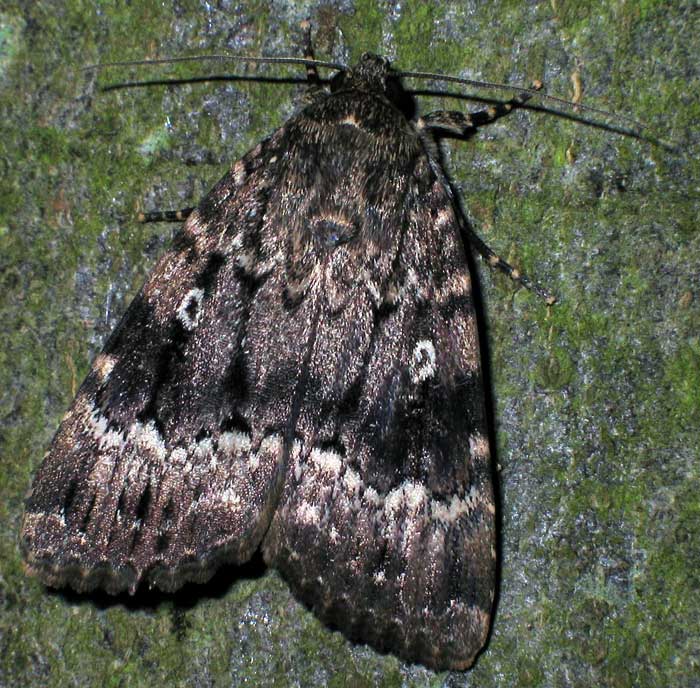
Amphipyra pyramidae (*)
Superregnum: Eukaryota
Cladus: Unikonta
Cladus: Opisthokonta
Cladus: Holozoa
Regnum: Animalia
Subregnum: Eumetazoa
Cladus: Bilateria
Cladus: Nephrozoa
Cladus: Protostomia
Cladus: Ecdysozoa
Cladus: Panarthropoda
Phylum: Arthropoda
Subphylum: Hexapoda
Classis: Insecta
Cladus: Dicondylia
Subclassis: Pterygota
Cladus: Metapterygota
Infraclassis: Neoptera
Cladus: Eumetabola
Cladus: Endopterygota
Superordo: Panorpida
Cladus: Amphiesmenoptera
Ordo: Lepidoptera
Subordo: Glossata
Cladus: Coelolepida
Cladus: Myoglossata
Cladus: Neolepidoptera
Infraordo: Heteroneura
Cladus: Eulepidoptera
Cladus: Ditrysia
Cladus: Apoditrysia
Cladus: Obtectomera
Cladus: Macroheterocera
Superfamilia: Noctuoidea
Familia: Noctuidae
Subfamilia: Amphipyrinae
Genus: Amphipyra
Species: Amphipyra pyramidea
Name
Amphipyra pyramidea Linnaeus
Vernacular names
беларуская: Соўка пірамідальная
français: Pyramide
日本語: シマカラスヨトウ
The copper underwing, humped green fruitworm or pyramidal green fruitworm (Amphipyra pyramidea) is a moth of the family Noctuidae. The species was first described by Carl Linnaeus in his 1758 10th edition of Systema Naturae.
Distribution
This species can be found across the Palaearctic region including Europe, North Africa, the Near East, Iran, southern Siberia, northern India, Korea and Japan.[1][2] It is rather common over the southern half of Britain.[3]
Description
This species has a wingspan of 47–54 mm,[3] the female usually slightly larger than the male. The forewings are brown marked with paler fascia and a pale, dark-centred stigma. The hindwings are a rich bright copper colour (hence the common name of "copper underwing").
It is very similar to Svensson's copper underwing (Amphipyra berbera) but identification is usually fairly straightforward by looking at some markings on the forewings,[4] the detail of the labial palps[3] and at the underside of the hindwings. This species has a pale area in the centre of the hindwings, contrasting with much darker marginal areas, while in A. berbera the whole underwing is more or less uniform in colour. See Townsend et al.[5] The larva is green with white markings and a pointed hump at the rear end.
Differentiation of A. pyramidea from A. berbera
A. pyramidea - red arrow points out a difference
A. berbera - red arrows point out a difference
Caterpillars of A. pyramidea (top) and A. berbera
Biology
It is a univoltine species. Hatching season is as early as June in some climates but they usually hatch July to October. Eggs are laid in deciduous trees. Larva can be found as early as April in some climates but usually emerge in May–June. A pyramidea flies at night from August to October[1] and is attracted to light and strongly to sugar.[3] It feeds on a variety of trees and shrubs, including ash tree (Fraxinus), privet (Ligustrum), honeysuckle (Lonicera), apple (Malus), oak (Quercus), Rhododendron, rose, wild service tree (Sorbus) and lilac (Syringa).[6][3][1][7] The species overwinters as an egg.
^ The flight season refers to the British Isles. This may vary in other parts of the range.
References
Savela, Markku (28 July 2019). "Amphipyra pyramidea (Linnaeus, 1758)". Lepidoptera and Some Other Life Forms. Retrieved 23 October 2019.
Fauna Europaea
Kimber, Ian. "73.062 BF2297 Copper Underwing Amphipyra pyramidea (Linnaeus, 1758)". UKMoths. Retrieved 23 October 2019.
Entomart
Martin C. Townsend, Jon Clifton and Brian Goodey (2010). British and Irish Moths: An Illustrated Guide to Selected Difficult Species. (covering the use of genitalia characters and other features) Butterfly Conservation.
Robinson, Gaden S.; Ackery, Phillip R.; Kitching, Ian J.; Beccaloni, George W.; Hernández, Luis M. (2010). "Search the database - introduction and help". HOSTS - A Database of the World's Lepidopteran Hostplants. Natural History Museum, London.
Mazzei, Paolo; Morel, Daniel & Panfili, Raniero. Moths and Butterflies of Europe and North Africa
Chinery, Michael (1991). Collins Guide to the Insects of Britain and Western Europe.
Skinner, Bernard (1984). The Colour Identification Guide to Moths of the British Isles.
Retrieved from "http://en.wikipedia.org/"
All text is available under the terms of the GNU Free Documentation License

